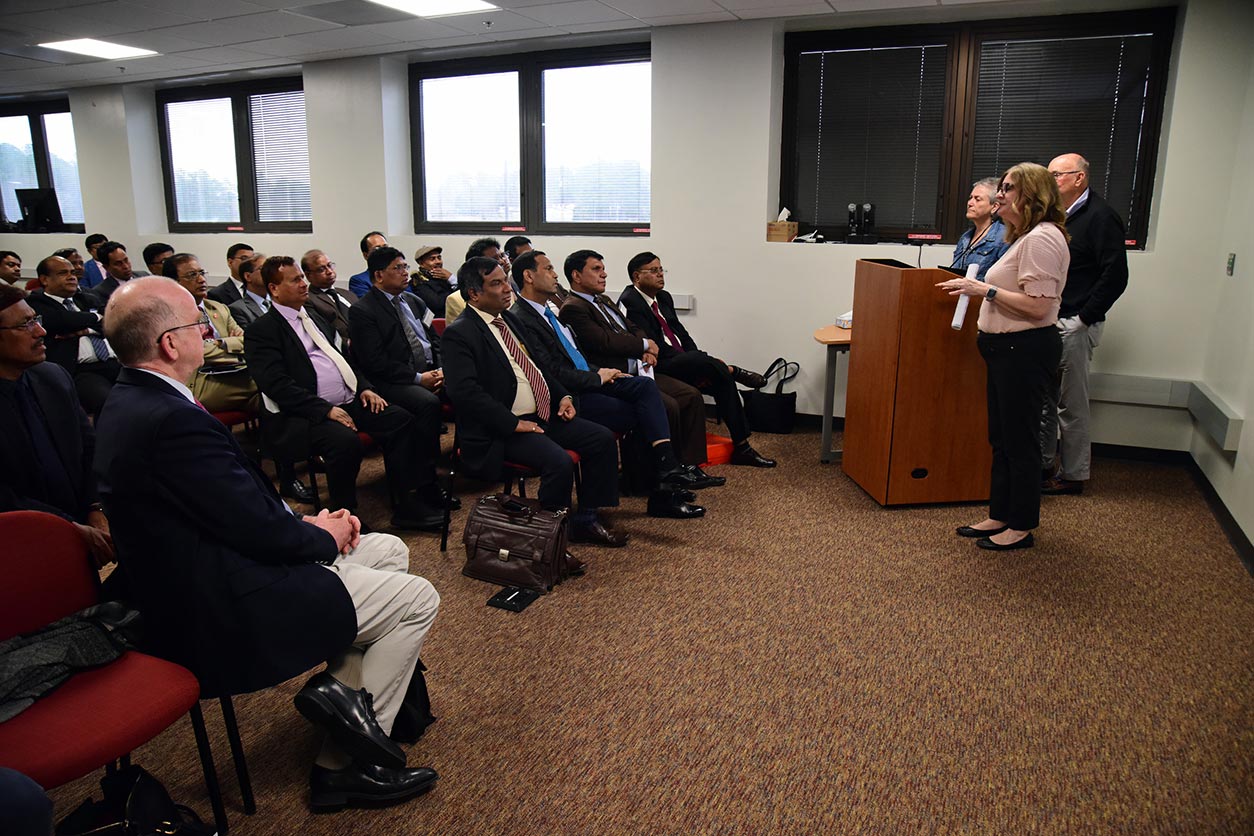Fifty officials from the Bangladesh Ministry of Public Administration visited NIEHS Mar. 5 to learn how the institute advances environmental health research in the United States and abroad — including in their home country. The afternoon visit was part of a two-week public policy course offered by the Duke Center for International Development.
 The Bangladeshi officials wanted to learn more about NIEHS research and how it might apply to their country. (Photo courtesy of Steve McCaw)
The Bangladeshi officials wanted to learn more about NIEHS research and how it might apply to their country. (Photo courtesy of Steve McCaw)“NIEHS focuses on a variety of environmental pollutants and how they affect human health,” Gwen Collman, Ph.D., the institute’s acting director, told the audience. “Our portfolio includes everything from basic molecular science … to toxicology research,” she said. Such work sometimes involves international collaboration.
“Our researchers have built partnerships with a variety of universities, clinical research groups, and epidemiologists throughout Bangladesh,” Collman noted. Over time, NIEHS has funded 36 research projects in the country. “The grants focus on a variety of topics, including arsenic, air pollution, cancer, and childhood growth and development,” she added.
 “We want to put our science in the hands of all the stakeholders who need it,” Collman said. (Photo courtesy of Steve McCaw)
“We want to put our science in the hands of all the stakeholders who need it,” Collman said. (Photo courtesy of Steve McCaw)Contamination from the Himalayas
Arsenic contamination is an issue important to many attendees. Arsenic is a chemical element found in the Earth’s crust that can poison ground water and soil. The substance is linked to a variety of human health problems, such as the following.
- Skin, lung, bladder, kidney, and liver cancer.
- Cardiovascular and respiratory diseases.
- Impaired brain development.
Millions of tube wells were installed in Bangladesh from the 1960s through the 1980s, to help citizens avoid surface water contaminated with bacteria. “Unfortunately, high levels of arsenic were detected in many of the wells,” said William Suk, Ph.D., director of the NIEHS Superfund Research Program (SRP). “It’s estimated that 25 to 40 million people in the country have been diagnosed with high levels of arsenic.”
 “The reality is that arsenic is not your problem alone,” said Suk. “It has been associated with millions upon millions of people worldwide.” (Photo courtesy of Steve McCaw)
“The reality is that arsenic is not your problem alone,” said Suk. “It has been associated with millions upon millions of people worldwide.” (Photo courtesy of Steve McCaw)Exposure comes from the Himalayan mountains north of Bangladesh. “The Himalayas have an incredible amount [arsenic in] bedrock and rock formations in the foothills,” he said.
The Health Effects of Arsenic Longitudinal Study(https://tools.niehs.nih.gov/srp/programs/Program_detail.cfm?Project_ID=P42ES0103490003) is an especially important project, according to Suk. SRP-funded scientists from Columbia University and the University of Chicago, working with researchers from the University of Dhaka in Bangladesh, are following a cohort of more than 35,000 Bangladeshis. Among other things, the team has tracked how the chemical affects residents over time, educated families on reducing exposure, and even provided health clinics.
Research hub tackles household air pollution
Bangladesh experiences environmental health problems beyond high arsenic levels. Kimberly Gray, Ph.D., from the NIEHS Population Health Branch, described a research hub — funded in part by the institute — that focuses largely on household air pollution. Such pollution is a significant issue across much of the country.
The Bangladesh Center for Global Environmental and Occupational Health is a collaboration among American and Bangladeshi researchers. The scientists aim to better understand how household air pollution affects cardiopulmonary and immune function in nonsmokers.
 Gray said that the hub helps to train early-career scientists in Bangladesh on environmental health research. (Photo courtesy of Steve McCaw)
Gray said that the hub helps to train early-career scientists in Bangladesh on environmental health research. (Photo courtesy of Steve McCaw)“The potential to significantly improve health not only in Bangladesh but for billions in South Asia, and to have good data on health outcomes, is going to be really phenomenal,” said Gray, who helps to oversee the program.
Learning experience
Following the presentations, the Bangladeshi officials asked about how NIEHS engages stakeholders, how arsenic affects crops, and other topics.
“On behalf of the government of Bangladesh, I would like to extend our gratitude to the U.S. government for funding these research projects,” said Supriya Kundu, who led the delegation. “We would also like to extend our sincere thanks to the leaders of this prestigious institute.”
The visit ended with a tour of NIEHS led by John Schelp, from the Office of Science Education and Diversity.
(Jesse Saffron, J.D., is a technical writer-editor in the NIEHS Office of Communications and Public Liaison.)









